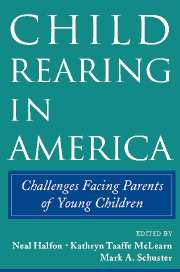Book contents
1 - Introduction and Overview
Published online by Cambridge University Press: 15 July 2009
Summary
RECENT PERSPECTIVES ON EARLY CHILDHOOD
The well-being of young children has become a popular topic as expansions of knowledge in the neuro- and behavioral sciences have documented the importance of the first three years in children's long-term learning, behavior, and health. Recent scholarly books and national research conferences have examined these issues from a variety of perspectives. In 1997, the National Academy of Sciences convened a three-year, multidisciplinary commission to examine and report on the science of early childhood. In 1999, RAND issued Investing in Our Children, which documented the benefits and savings associated with targeted early intervention programs. In 1996, 1997, and 2000, Time and Newsweek devoted entire special issues to the development of the young child. In 1997, the White House hosted conferences on childcare and on early child development and learning. Federal agencies have signaled their interest by expanding data collection on the early life predictors of educational success and supporting expansions of the Head Start program for children from birth to age 3. Numerous states have initiated aggressive early childhood agendas, focusing on childcare, health care, universal preschool, home visiting, and family support (Cauthen et al. 2000). All these efforts are evidence of a recognition of the importance of early child experience and a growing commitment to public policy that fosters the healthy development of our youngest children.
- Type
- Chapter
- Information
- Child Rearing in AmericaChallenges Facing Parents with Young Children, pp. 1 - 18Publisher: Cambridge University PressPrint publication year: 2002



